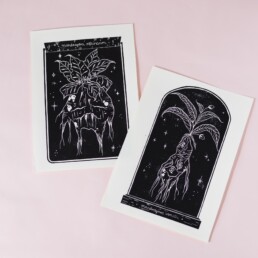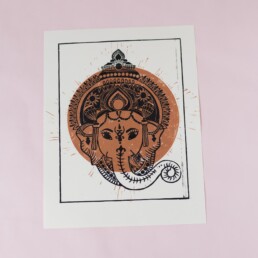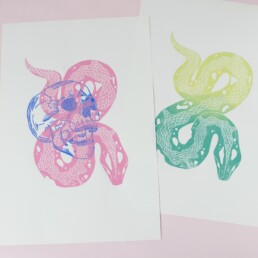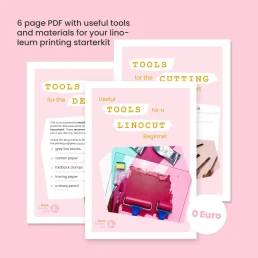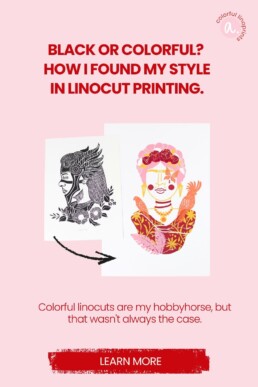
Finding your own linocut style – how my artistic process evolved
From black-and-white beginnings to vibrant portraits: Discover how my linocut style evolved over time and learn what can help you develop your own unique artistic voice.
I will help you understand linocut printing step by step, try it out for yourself, and create your own prints.
I’ve always been creative. As a child, I loved drawing, and later I went on to study design, where I discovered my passion for illustration. So when I started with linocut printing in 2018, I already had plenty of creative background and motivation — but honestly, I had no idea what my style should be.
And to be fair: if I hadn’t found a linocut style that felt natural to me early on — one that suits this technique, that I can constantly reinvent — I might have lost interest. Finding your own style gives you confidence, direction, and the feeling that you’ve truly arrived.
The Beginning: Black and White and Searching for Expression
My very first linocut print was a portrait of a Viking woman — my “Lagertha.” Looking back, it’s funny that her eyes are closed. I was afraid that a fixed gaze would look lifeless. That little insecurity eventually became my trademark: women with their eyes closed.
Back then, my prints looked very “typical linocut” — black and white, bold contrasts, hand-carved. I liked that, but something was missing. I wanted more depth, more emotion — something that felt more me.
First Experiments with Color and Themes
The next big step was an experiment: a print of a snake and skull — inspired by the “Dark Mark” from Harry Potter. It was the first time I played with color layering and overlapping shapes. It wasn’t quite there yet, but it felt like I was getting closer.
Then came a piece with cicadas and peonies — and that’s when I realized how important color is to me. Color changes everything. It shapes the mood, the atmosphere, the emotion. From that moment on, I knew that color would become a defining part of my linocut style.
The Breakthrough: My First “Girl” Portrait
In autumn 2018, I created the first girl that would define my current body of work — and everything clicked. This was exactly what I wanted to do! I was so excited about the result that I immediately started sketching the next one… and the next, and the next.
Over time, I added more and more symbolism to the motifs, playing with meaning and visual storytelling. That’s how my series concept was born — portraits of girls, each with their own symbolic theme and color palette.
This serial approach gave me structure and freedom at the same time: because the composition stayed the same, I could focus on creativity — the symbolism, the color choices, the emotion.
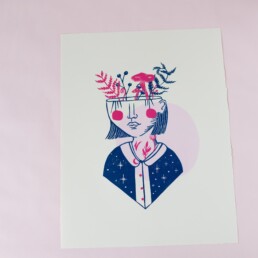
What I Learned: Finding a Linocut Style Takes Time
You can’t force a personal style — it develops naturally through practice and experimentation. Every print teaches you something. Even when you think you’re “off track,” you’re actually moving closer to what feels authentic.
And even once you’ve found your linocut style, it won’t stay fixed forever. As you grow more confident, you’ll start exploring new directions and influences. That’s part of the creative journey.
Don’t rush it. Explore what inspires you, notice what keeps showing up in your work, and pay attention to what feels easy and joyful. Those are often the clues to your personal linocut style. I recently saw a great video by Brooke Glaser on YouTube. Maybe this will help you. It’s more about illustration, but the two disciplines are still closely related.
Finding your own linocut style takes time, patience, and curiosity. Experiment with color, shapes, and themes — and one day, you’ll realize you’re not searching anymore. You’re simply creating. And that’s where your style truly begins.
I’m curious to see how my own work will evolve in the next few years — maybe it’ll look completely different. And that’s the beauty of it: style is always evolving.

